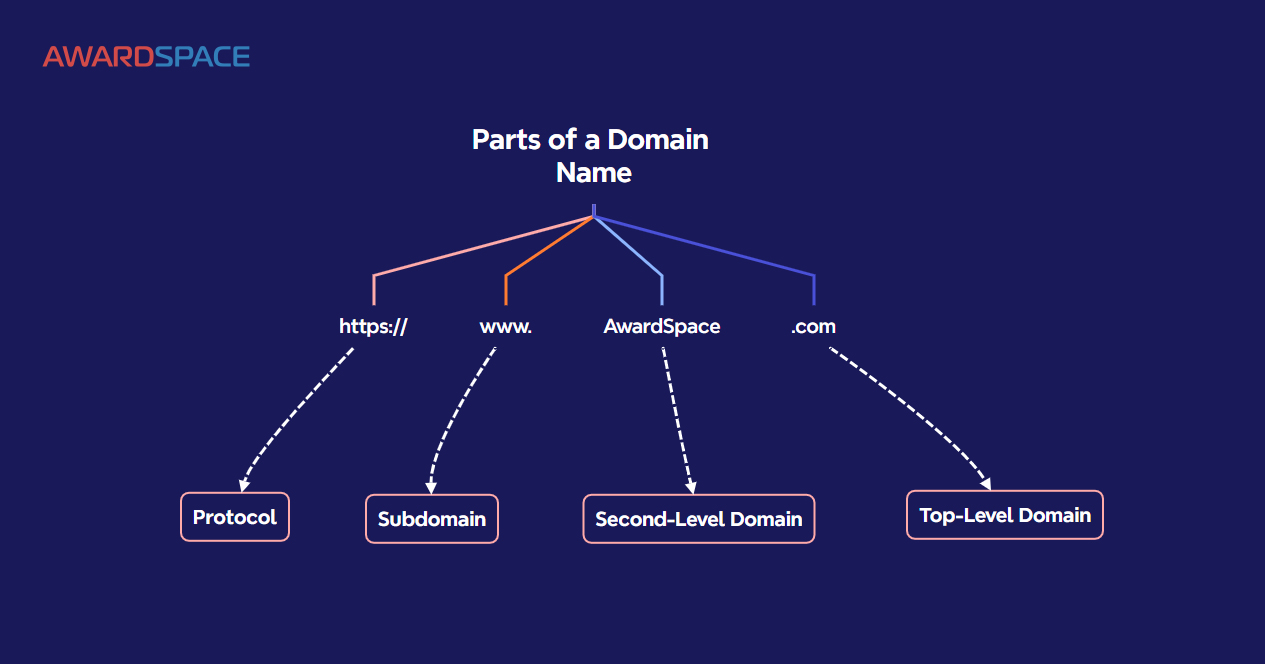A domain name, or simply a domain, is a central part of the Internet.
Confusing for many, domains play a crucial role in making the Internet more accessible and easier to use for all.
This article explains everything about the domains, so you get a deeper understanding of the term.
Table of Contents:
What is a Domain Name

A domain name is a string of symbols that form a word or a phrase, which makes sense to people.
This text-based label is connected to a website’s IP address and always leads to this particular website.
An IP address is a string of numbers and dots that tell the exact location of a website, or any other online resource on the Internet.
Devices such as computers, tablets, smartphones, and servers use IP addresses to locate where a given website is across the Web and open it.
For example, the IP address behind the domain name “AwardSpace.com” is this:
198.74.50.19:
By adopting this approach, the Internet allows people to freely type down words in search engines and open websites corresponding to these words without investing time in learning how to use IP addresses.
The idea behind domain names is simple – they are easy to use and memorize, unlike the strings of numbers and dots that comprise the different IP addresses.
In short, domain names help Internet users find and browse websites without having to work directly with IP addresses.
What are the Parts of a Domain Name

Domain names are comprised of several parts, giving off certain information to both computer devices and Internet users.
There are a total of 4 parts:
- HTTPS protocol. This part of the domain name is placed at the far-left side of the domain and gives information about what protocol is being used, so devices can transmit information via using it. In the example https://www.AwardSpace.com, the protocol part is “https://”
- Subdomain. The subdomain is an optional part of each domain name. It is used to separate certain types of website content from another website that remains within the domain of the original one. In most cases, brands use subdomains to separate their blogs, online shops, and forums from their main website. An example of a subdomain is https://blog.examplewebsite.com.
- Second-Level Domain. The second-level domain is the part of the domain name that you can fully customize. It should be unique, compared to all other registered domain names. In most cases, businesses use their brand name as a second-level domain. For example, AwardSpace uses this particular name as a second-level domain – https://www.AwardSpace.com
- Top-Level Domain. The top-level domain, or TLD, is the part of the domain placed at the right of the second-level domain and is separated by a dot. TLDs give additional information about what the website can be about – a business website, personal website, educational one, or country-based one. In the example, https://www.AwardSpace.com, the TLD is .com.
If you want to know more about the different parts of domain names, then check out our comprehensive article on the topic: Understanding the Different Parts of Domains
Read also: The Difference Between Domain Hosting and Domain Transfer
Do I Need a Domain Name for My Website

Technically, a domain name is not needed to launch а fully functional website.
However, getting a domain name is highly advisable. This is due to several equally important reasons:
- Greater website accessibility. Technically, your site visitors can use your website’s IP address to open it. However, this makes the entire process unnecessarily hard and tedious. Instead, a domain name can prompt them to open and browse your pages immediately.
- Websites with customized domains look professional and reliable. Usually, brands focus on using a domain name for their business website – this is not a coincidence. So, when choosing a domain name, look for something that sounds good and is relevant to your website topic.
- If you would promote your business via a website, using a domain will greatly help you with branding. A custom domain name can help you spread your business’s core ideas and principles.
- A domain name helps you look more professional in your email communication. If you have a business website, it is important to create presentable email accounts containing your website’s domain name, as this would contribute to more brand credibility, and authority and would look consistent through online channels
- Including relevant keywords in your website’s domain name can give you a kick in search result positions and an overall increase in organic traffic.
This is why, using a domain name for your website is very important.
Register yours today.
Conclusion
Domain names are an essential part of the Internet. Not only do they help Internet users find and browse the websites they wish to open, but they also make the entire process way simpler and faster.
Read also:
